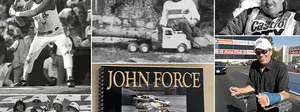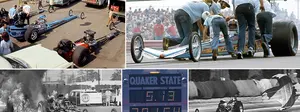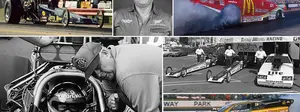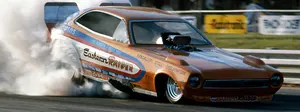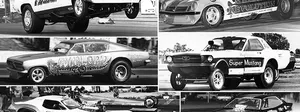

Remembering Zim
NHRA founder Wally Parks deservedly gets a lot of credit for organizing the sport of hot rodding in general and drag racing in specific, he was always the first one to tell you he certainly didn’t do it by himself. And because much of Wally’s endeavors were focused in the court of public and political opinion to ensure the sport’s growth, what he really needed were boots on the ground the foot soldiers to carry his message and vision to the masses.
In the earliest days of NHRA, that was the Safety Safari (nee Drag Safari) and guys like Bud Evans, Bud Coons, Chic Cannon, and Eric Rickman, and, later, regional and area advisors. By 1959, Parks had hired four Regional Directors -- Ed Eaton (Northeast), Ernie Schorb (Southeast), Tex Smith (Southwest), and Jack Merrill (Northwest) -– and had recruited 87 regional advisors and 75 area advisors. The Regional Directors hit the roads with their own version of a Safety Safari, visiting clubs and member tracks to further the NHRA's goals and missions, including overseeing the construction of new tracks.

Even though they had the four corners of the nation covered, the territories were just too big, and Parks settled on the idea of seven Division Directors with slightly smaller pieces of pie.
One of those was an eager young hot rodder named Darrell Zimmerman, who was hired to run the West Central (Division 5) region, comprising nine Midwest breadbasket states and parts of Canada. Zimmerman, who remained NHRA’s Division 5 Director until his retirement in 1994 but worked for years after in race control, passed away Wednesday at age 86, just two days shy of next birthday, after years of failing health.
Zimmerman had already been on the job for more than 20 years when I joined the NHRA team in 1982 and, because he worked national events until well into the 2000s, he was always part of my extended NHRA family, a grandfatherly presence who came to the track every day outfitted with three things: Cigars. Suspenders. And an ever-present good nature. Zim might be having a lousy day or an event may have gone sideways, but you'd almost never know it. He'd see you, his face would light up, he'd let out a giant belly laugh, maybe give your shoulder a good squeeze (Mr. Spock probably learned his Vulcan nerve pinch from Zim) or slap you on the back. He was good, good people. To paraphrase what a number of folks told me, he was exactly the kind of person the world needs today.

Zimmerman grew up hot rodding cars in Big Springs, Neb., where his family owned a farm. His first car, built while he was a junior in high school and a member of the Ramrods car club, was a ’36 Ford that he later traded for a ’47 Mercury. After a trip with friends to the Bonneville Salt Flats in 1954, he and his buddies convinced the local Sedgwick County Commissioners to hold a drag race on the 800-foot-long straightaway of the local oval track. With no official dragstrip in the area and street racing becoming a problem, they agreed. Zimmerman entered and won that race with a ’51 Ford with a bored and stroked flathead beneath the hood.
By 1954, Zimmerman -– who also worked construction and sold cars at a Chevrolet-Cadillac-Pontiac dealership -- was helping the Denver Timing Association with technical inspections and when NHRA staged its first National Championship Drags in Great Bend, Kan., in 1955, Zimmerman was on hand with a ’55 Chevy convertible B/Stocker. When he lined up to have his car checked by the tech officials, Zimmerman saw what seemed like an endless line of cars in front of him, so he did what Darrell Zimmerman always did: He offered to help.
“I walked up and said I could help tech the cars, and they put me to work right away,” he told me years ago. “When all of the cars were done, I asked if someone else would tech my car. I didn’t feel comfortable checking out my own vehicle. They said, ‘You’re a racer? We thought [Wally Parks sent you over to help.’ I didn’t know what they were talking about. I was just trying to help out.”

Zimmerman became part of the fabric at the U.S. Nationals and never missed one for the next 50-plus years.
“The U.S. Nationals was the first event, and since then it has always been the biggest and most prestigious event,” he said. “It’s an honor to be a participant, a worker, or a spectator of the U.S. Nationals because it’s the granddaddy of them all.”

Zimmerman was a pretty good racer. By his own accounting he won 122 class trophies and 35 Top Eliminator titles and set 12 track records at places like Platte Valley Dragway, Contiental Divide Raceway, Grand Island Dragway, Kearney Dragway, Amarillo Dragway, Great Bend Dragway, Scotts Bluff Dragway, Cheyenne Dragway, Midway Dragway, and many more. He also collected fistfulls of trophies at car shows for Best of Show, Best Engineered, and other honors.
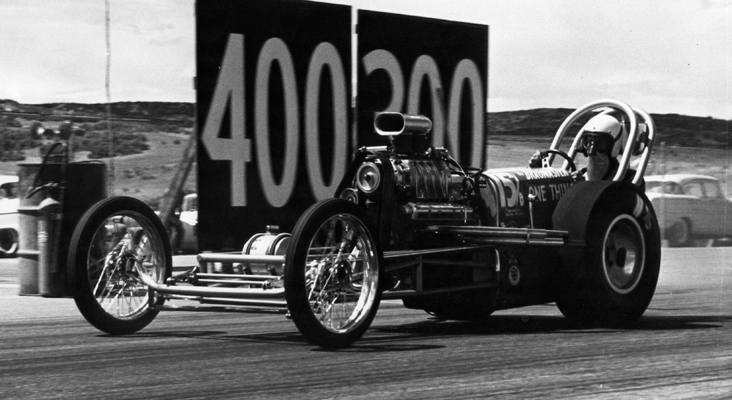
Other cars in his driving history included a '34 Ford pickup that competed in A/Gas, then his first dragster, the Al-Zim Special that ran in the A/Open Gas class, the Zim-Go B/Dragster, and then the DragMaster One-Thing (pictured above), which also ran in B/Dragster, then A and finally AA/Gas Dragster. His best pass was a 9.04 at 180 mph in the One-Thing. He took his last trip down the dragstrip in 1962 at Platte Valley.
As adept as he was tuning and driving, Zimmerman excelled in his operational capacity in racing. It was Jack Clark, the regional advisor for the Omaha, Neb., area that put Zimmerman's name on Parks' radar, and Zimmerman was relentless in promoting the sport and helping open racetracks, including Julesburg Raceway in his longtime Colorado base.

Among other tracks built under Zimmerman’s watch were Graybull Dragstrip (Wyoming), Five-State Raceway (Kansas), Donnybrooke Speedway (later known as Minnesota’s Brainerd Int’l Raceway), and Colorado tracks Erie Dragstrip, Rocky Mountain Dragway, Bandimere Speedway, and Pueblo Motorsports Park. His last major project was Heartland Park Topeka in Kansas, a dream seven years in the making -– “a track that many people said would never be built,” according to Zim -- that finally opened in 1989.

Wife Polly, whom he wed March 2, 1957, was always at his side, working from the Division 5 office and at the races, where she was either with him in the tower or at racer registration. Daughters Tammy and Daphne both worked in the Division 5 office until his retirement.

As I mentioned before, Zim was the Division 5 Director when I joined NHRA in 1982, along with Greg Xakellis (Division 1), Lex Dudas (2), Keith Ferrell (3), Dale Ham (4), Gene Bergstrom (6), and Bernie Partridge (7). Except for Xakeliis and Bergstrom, they’re all gone, but I was able to speak with “The X Man” about his long friendship with the Zimmermans and the whole husband-wife dynamic that was so evident in those first decades.
“Wally learned in his first marriage that this job can cause a problem with relationships, so he felt that if a husband and wife were both involved that they would not have a problem,” Xakellis said. “He understood how much time it takes to do this and to have them working together would keep the families together, and he even encouraged us to bring out kids, and they all grew up together and stayed together.”
“I first met Zim in 1964 at the U.S. Nationals,” recalled Xakellis, whose wife, Martee, also was heavily involved with Division 1 activities. “He was working on the tech line. I was working on the Division 1 Certification crew and we spent a lot of happy times together. I became the Division Tech Director a year later and the D1 DD in 1978, and Zim was always someone you could always look to, whether it was in which the tech Department, where we usually worked at the national events. I learned a lot from him. He was always someone you could look up to; you could ask him anything and he’d give you a straight answer.
“He and Polly would get together with Martee and I when a race was over and we’d go do things together. We had a lot of good times.”

Recently retired NHRA Vice President Graham Light was the Pacific Division Director from 1984 to ’86 and worked with Zim then and, later, as NHRA’s race director, with him in the running of national events.
“He was the last of the 'old guard'; he was a devoted family man, a hot rodder, a dedicated NHRA employee, an ambassador for the sport, a mentor, a friend to everyone he ever met, and a genuinely good person," said Light, who shared this photo of he and the Zimmermans from a 2018 visit to Julesburg.
Zimmerman was good with people, and always wanted to please, as Light recounted in these two telling stories.
"In the 1980s and ‘90s, division directors, the Competition Dept, and executives would meet annually to establish the rules for the following year. At one of those meetings, Zim read a letter from one of his racers requesting an unreasonable rule change. Zim presented all the reasons for such a change. After 20 minutes of debating, the proposal was put to a vote. The result of the vote was 100% against the change. In amazement, the group asked Zim why he’d spend so much time presenting the proposal only to vote against it. Zim replied that he never said he agreed with the proposal, he just wanted to present his racer’s request.
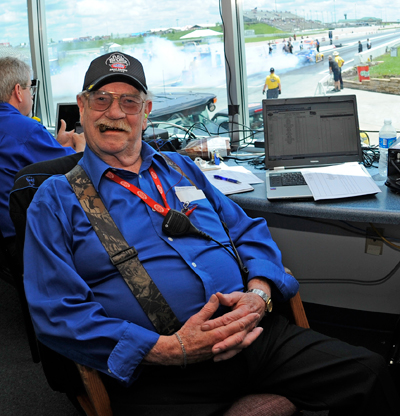
"One Thursday afternoon at the U.S. Nationals I was in one corner of the room working on my laptop and Zim was in the other corner on the radio directing the Pit Control and Staging staff when in came an irate middle-aged fan. The fan went directly to Zim and in a loud angry voice yelled ‘WE CAME TODAY TO WATCH THE HEMI CHALLENGE AND WERE TOLD THEY DON'T RUN UNTIL TOMORROW. WE WANT A REFUND.’ Zim's response was ‘Yep, they are great cars and put on a great show.’ The fan replied, ‘YOU DON'T UNDERSTAND, WE TOOK TIME OFF WORK,’to which Zim replied, "Weather’s gonna be great tomorrow; should be a great race.’ After a series of back to back comments, the fan calmed down and engaged with Zim in a conversation about Julesburg. The fans parting words were ‘See you tomorrow.’ “
But, as Light also pointed out -- and anyone who worked with or communicated with Zim knew –- you had to work your way through some “Zimmer-isms.”
“Zim was the Yogi Berra of drag racing,” said Light, referring to the syntax-challenged baseball managing great. “His Zimmer-isms were legendary within the drag racing community. At a Phoenix race, he spotted a 1955 Chevrolet from his Division and immediately informed us ‘That car has been around since it was new.’ The scary thing is that while his statements were confusing, we usually understood what he meant!
“Zim was an entertaining storyteller who often shared experiences of growing up in Julesburg. By Zim's own account, the town was named after a western outlaw, Jules Beni, who died in 1861 after being shot ‘7 times’ by a ‘6-shooter.’ As a teenager, Zim was the youngest member of the local car club, and when the older members were drafted for the Korean War, Zim, the only remaining club member, and claimed he was unanimously elected President. Thank you, Zim, for the memories that will forever be etched in our minds. Rest in Peace, my friend.”

The mentions of Zim’s malaprops reminded me of Zimmerman’s steadfast assertion that the human head weighs 40 pounds (it actually averages about 11 pounds). According to Light, the first time he made that claim, he was immediately challenged,
"Steve Gibbs gave him a strange look and told him to imagine having a 16-pound bowling ball on his shoulders and snapping it back and forth," Light remembers. "Zim's response was ‘It's 40 pounds, I have it written down at my office.’ "
The claim became such a remember part of his lore that when he retired in 1994, at a farewell celebration at the NHRA Finals. he was presented with a toilet (also known to some as a "head") with a 40-pound designation stenciled on the side.
As you can in the photos below that ran in our National Dragster coverage of the affair, Zimmerman enjoyed the roast, always able to laugh at himself as well as with others.
I mentioned earlier that Zim had a grandfatherly way about him, and was thrilled to hear from his granddaughter, Jennifer, who confirmed that was just who he was. Jennifer is the daughter of Dodie, second eldest of four daughters (Tammy, Dodie, Zanette, and Daphne).
“As a grandpa and a husband and a father, he was just so family-oriented all the time, and he was devoted to building a loving welcome home for not only his kids and his grandkids but his great-grandkids as well. My grandma and he have devoted their entire lives to making sure that that is always a home and that we can all come back to.
“One of my favorite things about my grandpa, and probably one of the things I'm going to miss the most, is that he was just so excited to see us -- all the time, every time we went over there. We could have seen him every day for the past week and we'd still walk in and he would just light up about any of us being there. I remember when we were kids that there was always cookies in the cabinet and always donuts and coffee on the counter and he was just so accommodating and wanted us to want to be there and he really did everything in his power to make that come to fruition.
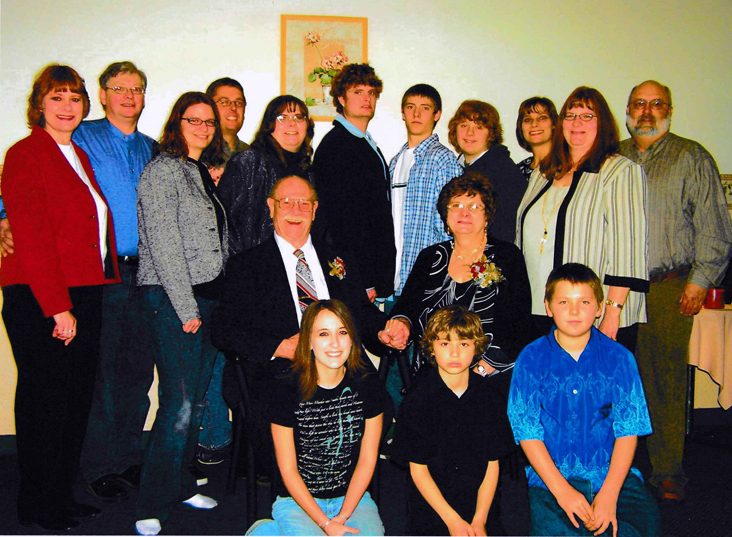
“My mom has said that he was probably the most romantic that she has ever known, that she felt that Hallmark modeled their romanticized men after him -– not only to my grandma but to his daughters as well. She said that he just did everything he could, and he bought them jewelry and just loved them and all of us so much. Christmas was always his thing. He just he loved Christmas and he made it such a magical affair for his kids and carried that tradition on to his grandkids and to his great-grandkids and certainly going to be a lot different this holiday season
“I think that he was happiest in a loud, full house with all of us there. He managed to balance a family with a career and did all of that so well.”
Jennifer also had the chance to see her grandfather in action usually at Bandimere Speedway and, like us, she was in awe.
“I remember when we would sit in the tower with him and he would have one radio in one ear and a different radio in the other ear and a radio on his chest, tracking the cars going through and carrying on conversations with his grandkids that were sitting there and carrying conversations with other people that were coming in,” he said. “He never missed a beat and his laugh could fill up a whole building.”
Her grandfather may well have been the most celebrated person in tiny Julesburg, which measures just about a square mile and has a population of about 1,200 people, no doubt all of whom he knew and knew him.
“It’s a very, very small community,” Jennifer told me. “In their last couple years, their health declined a lot and rapidly, and the diner in town –- ‘the’ meaning the only one in town -- would prepare them food and a lot of times would deliver it to them and often it wouldn't let them pay for it. The community has been very good at kind of taking care of them and supporting them in there in their last years

Zimmerman earned a lot of accolades in his career. He was inducted into the Division 5 Hall of Fame in 2003, the Colorado Motorsports Hall of Fame in 2004, and the Nebraska Auto Racing Hall of Fame in 2007. In 2007, he and Polly received the Brut Essence of Racing trubite at the Mile-High Nationals. He also laid claim to having been the first official subscriber to National Dragster when it debuted in early 1960.
In a 1999 interview with the magazine, Zimmerman reflected, “In the beginning, we had no idea that [drag racing] would become all this. Seeing our sport grow from what it was and having been able to be part of that growth has been extremely gratifying to me.
“I wouldn’t trade my years in drag racing for anything else.”
And we wouldn’t trade our years with Zim for anything either. Rest in peace, Zim.
Phil Burgess can be reached at pburgess@nhra.com
Hundreds of more articles like this can be found in the DRAGSTER INSIDER COLUMN ARCHIVE
























